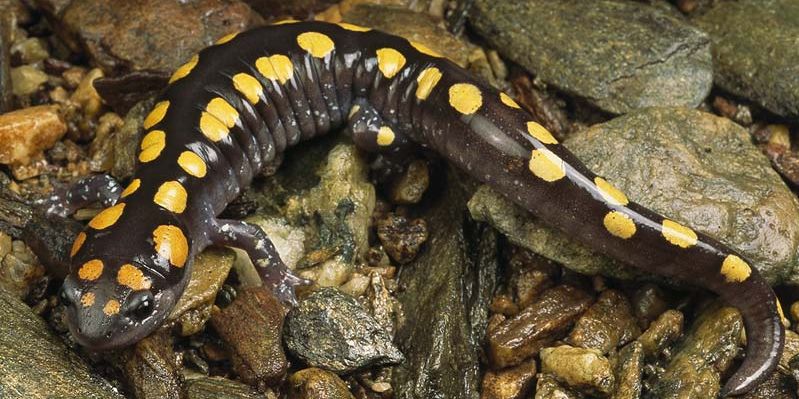
It’s raining hard at nine P.M. and the temperature is around 40 degrees. It’s March, and the ice has barely melted along the gravel road. You pull on your boots and heavy rain gear. You do? Yes! It might be the night of the Spotted Salamander! (Ambystoma maculatum)
Every spring these salamanders migrate from their underground forest homes to wetland ponds (“vernal pools”) to breed. There they perform their “love dance,” a rather frenzied mass of squirming bodies.
The challenge is figuring out when will be The Big Night. Many say it’s the first night of heavy rain after a winter thaw. Others say that it coincides with the return of the first phoebe. You take the chance of seeing nothing, returning home in your sodden clothing to await the next big rain and another opportunity.
Spotted salamanders, common in the northeast but rarely seen because they are active at night, are glossy black and about nine inches long, with two rows of bright yellow spots down their backs and tails. They spend most of their lives under rocks or logs in the forest, but once a year during the mating season they crawl up to half a mile to their breeding pools, often running the risk of crossing roads and nighttime traffic. In some places volunteers station themselves to help the salamanders cross, stopping traffic on lightly traveled surfaces.
Some state parks close their roads at crossings during vulnerable times. The salamanders return to the same breeding pool every year, and can live to be as old as 20 years or more.
The female lays one or more egg masses about 4” wide covered with a clear, milky, jelly-like substance, which stick to submerged branches and other vegetation. Each mass contains 100 to 200 eggs. You can see these masses with little black dots inside if you look along the edge of one of these pools. (Wood frog egg masses and other salamander masses look similar.) The adults leave the pool after a few days; the larvae hatch in a month or two and become salamanders in two to four months. The vernal pools are ideal homes since they contain no fish which would eat the eggs and larvae. The pools then dry up.
And those who missed the salamanders will have to wait another year!
